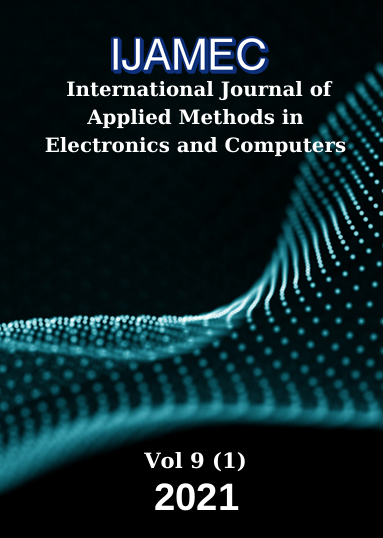A heuristic approach with artificial neural network for Parkinson’s disease
DOI:
https://doi.org/10.18100/ijamec.802599Keywords:
Artificial Neural Network, Feature Selection, Machine Learning, Parkinson, Wolf Search AlgorithmAbstract
Parkinson’s disease is a common neurological disorder. Its symptoms are more commonly in the form of motor misfunctioning. As the disease progresses, non-motor symptoms are also observed. In previous studies, feature selection methods have been used and shown significant benefits in the diagnosis of the Parkinson’s Disease in patients. Feature selection methods aim to improve the classification performance by eliminating non-valuable or less-valuable features. In this study, we aim to analyze, for diagnosing Parkinson’s disease, the voice recordings of the patients with applying a recent bio-inspired optimization technique namely the Wolf Search Algorithm (WSA). WSA is a bio-inspired heuristic optimization algorithm which has been inspired by the natural behavior of wolves in daily life. We also use an artificial neural network model with feature selection methods, for the purpose of classification of the Parkinson’s Disease in patients. We investigate the classification performances of the combinations of WSA-based feature selection method with well-known feature selection methods namely Information Gain and ReliefF feature selection methods. Experimental results show that ReliefF feature selection method outperform than the other feature selection method combinations for the diagnosis of the Parkinson’s Disease in patients.Downloads
References
“Statistics | Parkinson’s Foundation”. [Çevrimiçi]. Available at: https://www.parkinson.org/Understanding-Parkinsons/Statistics. [Erişim: 22-Tem-2020].
C. Blauwendraat, M. A. Nalls, ve A. B. Singleton, “The genetic architecture of Parkinson’s disease”, The Lancet Neurology, c. 19, sayı 2. Lancet Publishing Group, ss. 170–178, 01-Şub-2020.
M. Belić, V. Bobić, M. Badža, N. Šolaja, M. Đurić-Jovičić, ve V. S. Kostić, “Artificial intelligence for assisting diagnostics and assessment of Parkinson’s disease—A review”, Clinical Neurology and Neurosurgery, c. 184. Elsevier B.V., s. 105442, 01-Eyl-2019.
M. Shahbakhi, D. T. Far, ve E. Tahami, “Speech Analysis for Diagnosis of Parkinson’s Disease Using Genetic Algorithm and Support Vector Machine”, J. Biomed. Sci. Eng., c. 07, sayı 04, ss. 147–156, 2014.
C. O. Sakar vd., “A comparative analysis of speech signal processing algorithms for Parkinson’s disease classification and the use of the tunable Q-factor wavelet transform”, Appl. Soft Comput. J., c. 74, ss. 255–263, Oca. 2019.
G. Solana-Lavalle, J. C. Galán-Hernández, ve R. Rosas-Romero, “Automatic Parkinson disease detection at early stages as a pre-diagnosis tool by using classifiers and a small set of vocal features”, Biocybern. Biomed. Eng., c. 40, sayı 1, ss. 505–516, Oca. 2020.
J. S. Almeida vd., “Detecting Parkinson’s disease with sustained phonation and speech signals using machine learning techniques”, Pattern Recognit. Lett., c. 125, ss. 55–62, Tem. 2019.
M. Peker, B. Şen, ve D. Delen, “Computer-aided diagnosis of Parkinson’s disease using complex-valued neural networks and mRMR feature selection algorithm”, J. Healthc. Eng., c. 6, sayı 3, ss. 281–302, Ağu. 2015.
S. Kiranyaz, “Particle swarm optimization”, Adapt. Learn. Optim., c. 15, ss. 45–82, 2014.
M. Dorigo ve C. Blum, “Ant colony optimization theory: A survey”, Theor. Comput. Sci., c. 344, ss. 243–278, 2005.
J. Han, M. Kamber, ve J. Pei, “Data Mining. Concepts and Techniques, 3rd Edition (The Morgan Kaufmann Series in Data Management Systems)”, 2011.
M. Robnik-Šikonja ve I. Kononenko, “Theoretical and Empirical Analysis of ReliefF and RReliefF”, Mach. Learn., c. 53, sayı 1/2, ss. 23–69, 2003.
I. Kononenko, “Estimating Attributes: Analysis and Extensions of RELIEF”.
T. Hastie, R. Tibshirani, ve J. Friedman, “Springer Series in Statistics The Elements of Statistical Learning Data Mining, Inference, and Prediction”.
“Data Mining: Practical Machine Learning Tools and Techniques”. [Çevrimiçi]. Available at: https://www.cs.waikato.ac.nz/ml/weka/book.html. [Erişim: 06-Ağu-2020].
R. Tang, S. Fong, X. S. Yang, ve S. Deb, “Wolf search algorithm with ephemeral memory”, içinde 7th International Conference on Digital Information Management, ICDIM 2012, 2012, ss. 165–172.
Downloads
Published
Issue
Section
License
Copyright (c) 2021 International Journal of Applied Methods in Electronics and Computers

This work is licensed under a Creative Commons Attribution-ShareAlike 4.0 International License.





